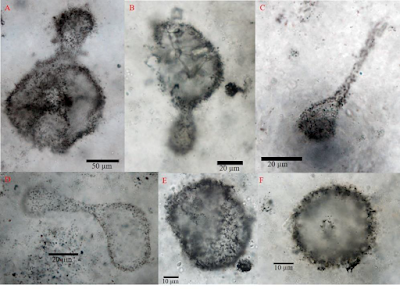The first Micro-organisms appeared some time during the Archean Eon (4000 to 2500 million years ago), and began to make changes to their environment, culminating in the Great Oxygenation Event, which is taken to mark the boundary between the Archean and the Proterozoic, 2500 million years ago, when oxygen levels built up to the point at which the Earth switched from having a weakly reducing atmosphere to a weakly oxidising one. These terms derive from the negative charge of electrons, that mean that when an atom accepts an extra electron it's overall charge is reduced, while oxygen tends to accept extra electrons, so atoms forming a bond with it can donate an electron and raise their charge, thus an atmosphere dominated by gasses which tend to donate electrons when they react with other substances is reducing, while one dominated by gasses which tend to accept electrons is oxidising). Fossils of Micro-organisms from this period are therefore highly sought after by palaeontologists studying early life, but to date very through have been discovered, with all known fossils from this period coming from just 15 sites around the world.
In a paper presented at the Astrobiology Science Convention in Washington DC on 24 June 2019, Andrea Corpolongo and Andrew Czaja of the Department of Geology at the University of Cincinnati, describe a new source of Archean microfossils from the Gamohaan Formation of the Kaapvaal Craton in South Africa.
The Gamohaan Formation is a ~110 m thick succession of granular and laminated limestones that forms part of the Neoarchaean Campbellrand Subgroup of the Transvaal Supergroup. The Gamohaan limestones contain ripple cross-lamination near their base, which is taken as indicative of an energetic shallow-water environment, while higher up it is dominated by laminated limestones with a high organic matter content, and structures associated with microbial matting. The formation is brecciated in places, and contains thin dolomite layers and iron sulphide nodules.
The microfossils were three-dimensionally preserved in black chert within a small, domal Stromatolite that formed in a shallow marine setting on a carbonate shelf system at 2.52 billion years ago (Corpolongo and Czaja cite this as being only 200 million years before the Great Oxygenation Event, though the exact date of this is unclear, with many authors putting it as late as 2400 million years ago. Stromatolites are formed by layers of micro-organisms forming biofilms
on the surface of sediments in shallow water environments. Typically
such films are buried by sediments periodically, with a new biofilm
forming on the surface. Over time this builds up to a distinctive
structure with layers of organic and inorganic material, a Stromatolite.
The earliest Stromatolites appear in the fossil record of Earth about
3.5 billion years ago, though it has been argued that these could form abiotically (i.e. without micro-organisms).
(A)-(D) Photomicrographs depicting some of the large, morphologically unique microfossils observed in petrographic thin sections made from black chert collected in the Gamohaan Formation, South Africa. (E)-(F) Two of more than 200 coccoid/oblong microfossils found amidst morphologically similar microfossils in one petrographic thin section of Gamohaan Chert.
See also...
Follow Sciency Thoughts on Facebook.







